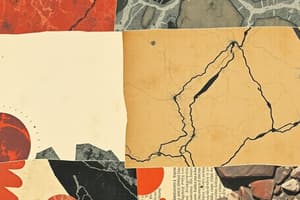Podcast
Questions and Answers
How are igneous rocks formed?
How are igneous rocks formed?
- By the slow cooling of magma beneath the Earth's surface
- From the solidification of molten rock (correct)
- From the accumulation of sediments
- Through the compression of existing rocks
What is the main characteristic that distinguishes extrusive rocks from intrusive rocks?
What is the main characteristic that distinguishes extrusive rocks from intrusive rocks?
- Formation depth
- Color variation
- Density
- Texture (correct)
Which process leads to the formation of sedimentary rocks?
Which process leads to the formation of sedimentary rocks?
- Accumulation and cementation of sediments (correct)
- Solidification of molten rock
- Compression of existing rocks
- High-pressure metamorphism
What is a common feature of sedimentary rocks that helps in their identification?
What is a common feature of sedimentary rocks that helps in their identification?
Which type of rock would likely contain fossils due to their formation process?
Which type of rock would likely contain fossils due to their formation process?
What is the primary factor responsible for the formation of metamorphic rocks?
What is the primary factor responsible for the formation of metamorphic rocks?
Which rock type can be transformed into marble through the process of metamorphism?
Which rock type can be transformed into marble through the process of metamorphism?
In the rock cycle, what is the initial form of rocks before they are eroded and transformed into new rocks?
In the rock cycle, what is the initial form of rocks before they are eroded and transformed into new rocks?
Which characteristic is NOT typically used in the identification of rocks?
Which characteristic is NOT typically used in the identification of rocks?
What is rock classification primarily important for understanding?
What is rock classification primarily important for understanding?
Flashcards
Igneous Rocks
Igneous Rocks
Rocks formed from cooled and solidified magma. These rocks can be either extrusive (volcanic) or intrusive (plutonic) depending on where they cool.
Extrusive Rocks
Extrusive Rocks
Igneous rocks formed from magma that cools and solidifies on the Earth's surface. These rocks usually have a fine-grained texture.
Intrusive Rocks
Intrusive Rocks
Igneous rocks formed from magma that cools and solidifies beneath the Earth's surface. They generally have a coarser-grained texture.
Sedimentary Rocks
Sedimentary Rocks
Signup and view all the flashcards
Metamorphic Rocks
Metamorphic Rocks
Signup and view all the flashcards
The Rock Cycle
The Rock Cycle
Signup and view all the flashcards
Rock Identification
Rock Identification
Signup and view all the flashcards
Minerals
Minerals
Signup and view all the flashcards
Grain Size
Grain Size
Signup and view all the flashcards
Texture
Texture
Signup and view all the flashcards
Study Notes
Rock Classification
Rock classification is a fundamental aspect of geology, helping us understand the Earth's structure, history, and processes. The three main types of rocks are igneous, sedimentary, and metamorphic, each with distinct characteristics and formation processes.
Igneous Rocks
Igneous rocks are formed from cooled and solidified magma, which is a molten rock found either within the Earth or on its surface. There are two main categories of igneous rocks: extrusive (or volcanic) and intrusive (or plutonic).
Extrusive Rocks
Extrusive rocks form when magma reaches the Earth's surface, where it cools and solidifies to form rocks such as basalt and rhyolite. These rocks often have a fine-grained texture due to the rapid cooling process.
Intrusive Rocks
Intrusive rocks form when magma does not reach the surface and instead cools slowly beneath the Earth's surface. This slow cooling process allows the minerals to form larger crystals, resulting in coarser-grained rocks like granite.
Sedimentary Rocks
Sedimentary rocks are formed from the accumulation of sediments, which are fragments of material that are eroded from their original location and transported by water, wind, or ice. These rocks are often layered and can be made up of grains like sand or silt, or organic materials like shells or plant matter. Common sedimentary rocks include sandstone, shale, and limestone.
Metamorphic Rocks
Metamorphic rocks are formed when existing rocks are subjected to high temperatures, pressures, or exposure to fluids like water. This process transforms the original rock into a new form, such as marble from limestone or slate from shale. Metamorphism can occur naturally within the Earth's crust or through human activities like mining or industrial processes.
The Rock Cycle
The rock cycle is the process by which rocks are transformed from one type to another over time. This cycle involves the continuous movement of rocks through the Earth's crust, from their formation as magma to their eventual erosion and transformation into new rocks.
Rock Identification
Identifying rocks is an essential skill for geologists and other professionals working in fields like construction, mining, and environmental science. Rock identification is typically based on various characteristics such as texture, grain size, color, and mineral composition.
In summary, rock classification is a critical tool for understanding the Earth's geology and history. By studying the different types of rocks and their formation processes, we can gain insights into the planet's structure, processes, and the natural resources we rely on.
Studying That Suits You
Use AI to generate personalized quizzes and flashcards to suit your learning preferences.




